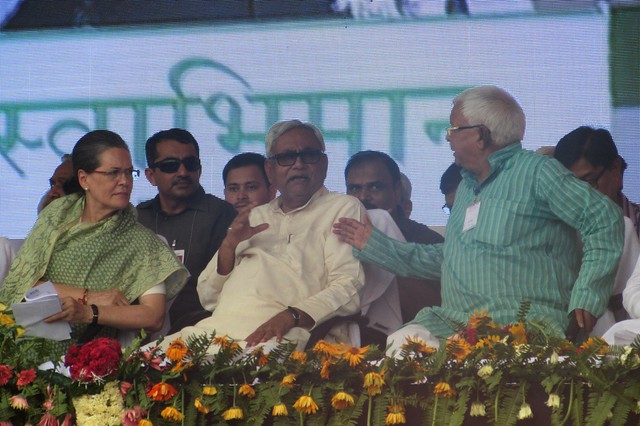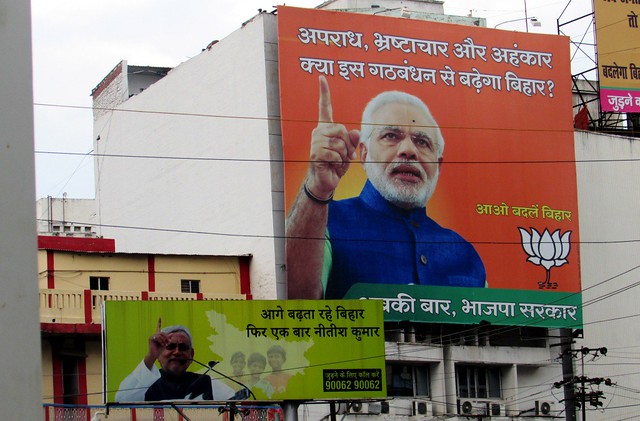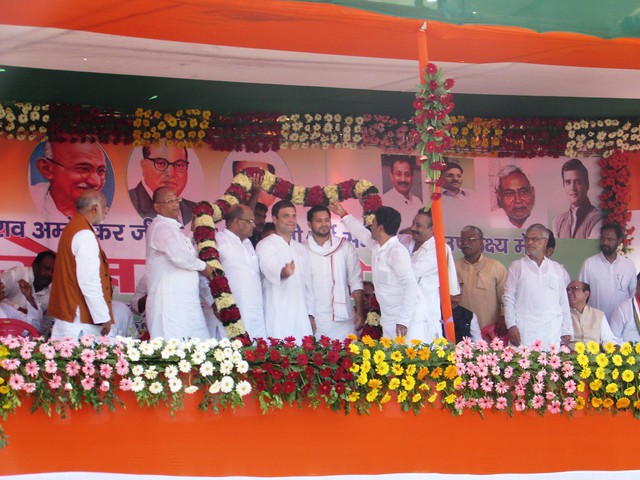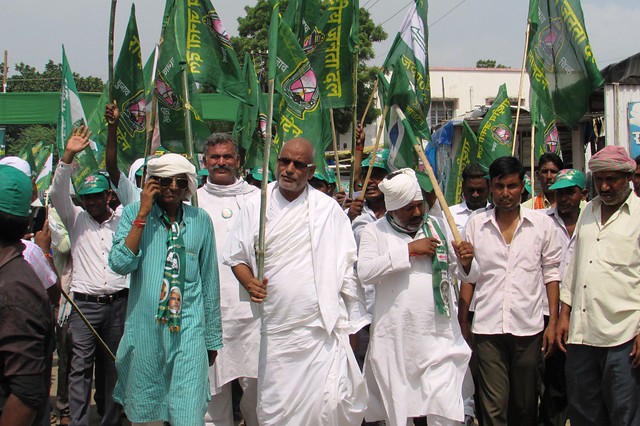By Sanjay Kumar & Badre Alam,
“For a successful revolution it is not enough that there is discontent. What is required is a profound and thorough conviction of the justice, necessity and importance of political and social rights.”- Dr. B.R. Ambedkar
It would not be wrong to say that OBC (other backward caste) ‘sub-nationalism’ came out, after the Mandalisation of Indian Politics in late 80 and 90s, which mainly focused on social justice. This essay aims to shed light on discourse around Mandal-II (Janta Privar) v/s Kamandal-II (Hindutva Politics) political fight with special reference to Bihar assembly election, which is going to take place soon. This essay demonstrates that Janta Parivar has ‘political potential’ to contain the might of Hinduvta juggernaut in Bihar provided that Privar incorporates the agenda of secular and inclusive social justice along with the principal of equality in its political agenda in words and spirit.

Leaders of Grant Alliance during a rally in Patna
During the anti-colonial movement, diverse competing perspectives had emerged to conceptualise the ‘Idea of India’ which was in fact represented by the different political dispensation. Broadly speaking, Congress political vision was based on the idea of secular and liberal nationalism. In similar way, but somehow different, left forces talked about secularism along with socio-economic equality. Contrary to both Congress and Left, right wing forces had put-forth the concept of cultural nationalism. However; there was an also some voice which was less visible. For instance, Amedkarite forces, which had put-forth agenda of equality, social justice, and fraternity for depressed classes.
Mandal Politics and Social Justice
The emergence of Janta Parivar as political force has in our view inaugurated a new ‘political culture’ in India. Social scientists like Yogendra Yaday have called the rise of low caste politics as ‘second democratic upsurge’ in India. In similar vein, a noted social scientist Christophe Jaffrlot has conceptualised the assertion of caste politics and rise of low caste as a ‘silent revolution’ in North India. In short, one may argue that ‘politicisation’ of lower caste has widened and deepened the ‘culture of democracy’ in India.
However, it is very strange to notice that ‘Mandal politics also accompanied simultaneously with ‘Mandir Politics’ ( Kamandal politics) in Indian society. To analyse the upsurge of this tension in Indian politics, some scholars have observed that whenever caste assertions took place; communal politics would rise to create the so-called larger ‘Hindu unity.’ Babri Masjid demolition (1992) by the communal forces can be a case in regard to this point.
We argue, on the contrary, that Mandal Politics-II if accompanied with idea of inclusive social justice and equality has a ‘political potential’ to defeat Hindutva juggernaut (Kamandal-II) in the upcoming Bihar assembly election. Before coming to these issues, let us unpack the manner in which Mandal politics have shaped political discourse particularly on theme of ‘quota politics’ and social justice with critical lens.

To understand different traditions of social justice, in the Indian context, a noted social scientist Professor Gopal Guru mentions that there are two different traditions on social justice. One is known as orthodox tradition which focuses on governing and disciplining rather than enabling. And second one is heterodox tradition, which tries to define social justice through radical interrogation of caste system and existing social hierarchies. (Gopal Guru (2013), “Social Justice”, in Niraja Gopal Jayal and Pratab Bhanu Mehta (Ed), The oxford companion to politics in India, New Delhi. OUP)
Keeping Guru Insights in mind, it is clear that the champions of Mandal politics have also not abolished the existing caste system. And therefore, one cannot deny the fact that in the name of Mandal politics, only some castes have cornered the benefit more than other sub-caste within OBCs group. And more importantly, one can see that intra-group inequality has widened amongst subaltern classes. When Lalu Prasad Yadav and Mulayam Singh Yadav became CMs of respective states, they used reservation policy to promote their caste interests. In short, one could argue that they (Janta Privar) have used the language of OBCs as ‘political community’ during the election campaign, but ironically, they had promoted their own family members and Yadav’s caste interests.
One should not misunderstand the problems as inherent in Mandal Commission report itself. If we look at Mandal commission holistically, it would be right to say that this report has laid down the agenda of social justice and empowerment of those social groups who are socially and educationally backward. To put differently, Janta privar in our views have done serious mistakes for not implementing the spirit of Mandal commission holistically. That is why communal and feudal forces had opportunities to politically exploit those castes and social groups who had not benefited from Lalu and Nitish Kumar regimes. In the neo-liberal times, it has become imperative for the Janta privar to talk not only about ‘quota politics’ but also fight with the capitalists, corporate and communal forces to bring the agenda of social justice and equality at home. Besides, they must also put political pressure on Indian state to carry forward the socio-economic programmes for disempowered section of society.
Further, even Janta parivar has also not properly addressed caste and communal violence, which had took place in Bihar in their regime. It is fact that Janta privar and its coalition such as JD (U) and RJD have ruled in Bihar nearly 25 years; but it is ironical that caste and communal strife continue unabated. In this regard, several committee and commission reports have also revealed that caste atrocities such as Bathani Tola, Laxmanpur Bathe, Shankarbigha, Narayanpur, Miyanpur etc took place, when the so-called champions of the social justice parties were in power. For instance, Bathani Tola experienced a brutal assault in 1996, in which 21 lives, including women and children lost their life. Successive ruling governments have utterly failed to deliver justice to affected victims. It is quite unfortunate that even today, those who are fond guilty in caste atrocities are roaming freely.

Rahul Gandhi during a rall in Bihar
BJP-RSS response on Social Justice
Christophe Jaffrelot mentions that Hindu nationalist movement has always had upper caste character and Hindutva ideology relies on brahmanical view of society. Further he said that RSS mouth piece ‘Organiser’ publically uphold the cause of upper caste. (C. Jafferlot, India’s Silent Revolution: the rise of the low Castes in north India, Permanent Black, New Delhi, 201.) For instance, when V.P Singh announced the implementation of recommendations of Mandal Commission in 1990, RSS immediately opposed it.
It is ironical to see that even in 2014 BJP Lok Sabha election manifesto, word reservation was not mentioned. Instead of reservation BJP has stressed more on Samajik Samrasata (social harmony). More recently, RSS Chief Mohan Bhagawat has openly said that reservation policy must be put to review by government. To put it differently, BJP-RSS concept of social justice is not based on principal of justice and equality. In short, keeping theoretical arguments of Gopal Guru in mind, on could argue that BJP-RSS concept of social justice is based on orthodox traditions rather than radical tradition as found in the writings of Phule and Ambedkar.
In the central government of Narendra Modi, there are total 27 cabinet ministers and it is surprising to know that 20 of them are from upper castes. And most important is that all RSS chiefs till today came from upper caste brahmins. In Bihar upper caste percentage of population is nearly 15 % but they have got 66 tickets; while the OBCs are 51% and Dalit 16%, but they have got only 76 tickets in coming Bihar election. The grand alliance has given has given 134 tickets to lower castes and 39 tickets to upper caste.

From distribution of tickets, it is clear that BJP is following the method social engineering, for capturing poltical power. Jaffrelot talks of social engineering as a method to promote non-elite group within the party apparatus including giving more OBCs as electoral candidates. However, it is clear that while distributing tickets BJP have given in fact more preference to upper caste in upcoming Bihar election.
Moreover, it is interesting to note that BJP’s mass cultural organization like RSS and VHP have even rejected the concept of social engineering while giving proper representation in various cultural outfits. Besides, most of the RSS officials till today came from the upper caste particularly from Brahmin caste. On the basis of above empirical reality, it is clear that BJP distribution of tickets is not for deepening the concept of egalitarianism and social justice. And therefore it is not wrong to say that BJP’s concept of the so-called ‘social engineering’ is only to get electoral gain and political power. In this regard Ananya Vajpeyi, a noted historian also points out that BJP and RSS want to maintain dominance in body politic.
She writes that under the government of Hindu right, India is witnessing another phase of reaction and orthodoxy, a return to medieval brahminical values that seek to monopolise rights for select few and turn everyone else out of the body politic.( ‘The reactionary present’. The Hindu, Oct. 6. 2015)
The BJP’s vision document 2015, for Bihar promises a shower of gifts, Scooties for girls, colour TV set for Dalits and laptops for 50,000 students and 5,000 scooties for girls. BJP vision document also promises that we should give land for all, landless people for housing, pure drinking water, toilet and electricity by 2022.

However, it is well known fact that BJP had made similar promises during the 2014 Lok Sabha elections but one can ask here, what happens to those promises? In reality nothing concrete has been done at the ground level. On the contrary, last one year of Modi’s government has witnessed various communal incidences mainly perpetuated by the goons of RSS and Bajrang Dal. Moreover, communal and nefarious activities such as Ghar wapsi, Love Jihad, beef ban, attacks on minorities are still continued unabated.
Mandal-II versus Kamandal-II: Way forward
On the basis of above discussions, it is not wrong to argue that BJP-RSS agenda of the so-called ‘social engineering’ and the ‘development politics’ is nothing but to uphold the brahmanical upper caste hegemony. It is well known fact that on the development issues, some social scientists and economists have rightly argued that Modi’s model of development has only benefited corporate and upper classes, which could be easily noticed in the case of Gujarat. Recent ongoing Hardik Patel agitation on issue of reservation for Patels can be a case in point here.
In given political context, we would like to suggest that if Janta Parivar is truly interested to defeat communal forces, it must uphold the radical legacy of ‘Social Justice’ as conceptualised by socialist leaders. Another important point to be highlighted here is that; if Janta Parivar is committed to politically defeat Kamandal-II (Hindutva politics), it must uphold and represent the aspirations of subaltern masses rather than giving priority to particular caste interests.
…
(Sanjay Kumar ([email protected]) is Ph.D Research Scholar at Academy International Studies, Jamia Millia Islamia, New Delhi. Badre Alam ([email protected]) is Ph.D, Research Scholar at Political Science Department, University of Delhi.)

